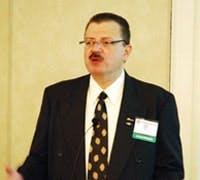Integrated Systems Keep Plants Nimble
Some companies do more with less. A very few companies do a lot more with less.
For instance, the capacity of Portland cement kilns has expanded over the years from producing hundreds of tons per day to upwards of 10,000 tons per day, and they even use slightly less total energy, according to Jaime Ramirez Barajas, vice president and process control systems specialist at Mexico-based Cemex Technology.
How have these kilns and their plants achieved these gains? They continually improved their controls and automation equipment and architectures, explained Ramirez at Rockwell Automation’s Automation Fair in Nashville, Tenn., this past November.
Dawn of a New Architecture
Jaime Ramirez Barajas, vice president and process control systems specialist at Mexico-based Cemex Technology, says integrated control architectures that are good at regulatory and sequential control, meet all the users’ technical requirements and reduce total cost of ownership are an evolutionary step at his company.
Over four decades, Cemex’s plants migrated from relays, pneumatics, analog signals, PLCs and distributed control systems to increasingly hybridized, intelligent and now integrated and even wireless controls.
“The typical distribution of I/O signals in a cement plant is about 85% digital, 13% analog and 2% PID controllers,” said Ramirez. “Process control, quality control and machinery-condition monitoring depend on analog variables and regulatory controls. Also, the three control system architectures in cement plants are DCS; hybrid DCS and PLC; and PLC integrated with PCs. Hybrid DCS and PLC systems are good for regulatory and sequential control, but they’re costly to maintain and their operators need a lot of training, said Ramirez.
“The most recent move has been to integrated control architectures that are good at regulatory and sequential control and meet all the users’ technical requirements but do it at a lower cost of ownership,” said Ramirez.
To ease the pain of this evolution and better guide its progress, the company’s staff spent seven days developing its Cemex Strategic Automation Plan (CSAP).
Consequently, when selecting a new control system, Ramirez reported that Cemex now routinely considers several issues. These include operational safety and reliability; production quality; enabling one operator to control the plant; programming that ensures easy maintainability; continuous operation at the lowest possible cost; easy integration with other Cemex information systems; server, data, communications and controls redundancy; simple online system changes; and a good migration path.
“Our recommendation for automation projects is to use integrated systems,” added Ramirez. “This means using one non-proprietary computer hardware platform, which reduces total investment, spare parts, needs and total cost of ownership over time. It also means using one common software platform, which facilitates systems design, programming, maintenance and documentation. An integrated control system is the best option for today and in the future.” Ramirez and company selected Rockwell’s ControlLogix toward these ends.
In addition, Ramirez said Cemex’s basic design directives for its integrated controls require that they must have independent controllers for each process area to avoid propagating any failures. They also must centralize controllers in a control room; use best-in-class PLCs and HMI components; use Ethernet as the backbone for client-server-controller communications; use smart motor control center (MCC) technology to minimize process downtime; reduce troubleshooting and mean time to repair (MTTR); and enable management and reporting of plant equipment status, operation parameters and alarming of process and equipment operation to upper-level systems.
Intelligent MCCs need fewer physical I/O signals and offer more diagnostic and monitoring features. “Using intelligent MCCs saved us almost 18% compared to using conventional MCC technology,” explained Ramirez.
By implementing these advances and integrated controls, Ramirez reported that Cemex had greatly improved its operations and efficiency in recent years. For example, shutdown diagnostic time dropped from more than 30 minutes in the 1990s to less than 1 minute now. Formerly required backup/redundancy functions now can be optional. The firm’s once-proprietary hardware and software platforms are now open and use smart field instrumentation and networking. “All of this further reduced the cost of our implementation engineering, maintenance and updates,” reported Ramirez.
Finally, Cemex also implemented several advanced process control (APC) capabilities, including model-predictive controls and neural networks from Pavilion. “The real benefit of applying APC is standardizing our operation criteria, freeing up operators from routine activities, increasing our operating consistency and stability and quality,” said Ramirez. “For example, Pavilion’s APC helped us reduce standard deviation in product quality at mills for two different cement types by 33% and 24%, and it cut production deviation by 17% and 21% at the same time.”


